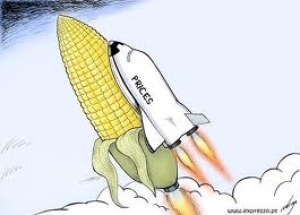World Markets

Beef and dairy producers have felt the heat this summer, as corn prices sky rocketed due to a shortage of supply and increased competition from the biofuels market.
A report put together by the Texas A&M University and Doane Advisory Services says that despite this, beef and dairy farmers are better off due to higher beef and milk prices offsetting the higher feed costs.
This study shows the differences in the economic well being of cow-calf ranches and dairy farms before and after the enactment of the Energy Independence and Security Act of 2007. Six ranches and six dairies were surveyed.
The January 2007 and January 2011 Food and Agricultural Policy Research Institute (FAPRI) Baselines are used for the current report.
Beef Cattle
Per head costs of feed and crop production on the beef cattle ranches show an increase from the 2007 Baseline to the 2011 Baseline.
For example, the South Dakota beef cattle ranch with 375 cows would see about a $1 to $4/head increase in feed costs under the 2011 Baseline.
The ranches with the highest per head increases in feed costs were in the Texas Rolling Plains and Florida.
Total costs per head increased for all of the ranches.
This analysis represents a partial look at the cattle industry in that it only examines cow-calf production. No stocker operations or feedlots are included. Cow-calf production uses little purchased feed relative to total costs because ranches rely on grazing pastures and range.
It is also important to note that this analysis uses an annual model to develop the baseline Annual models use annual data to develop the baseline. There is considerable within year seasonality in prices and cow-calf producers normally sell most of their calves at one point in the year (most commonly in the Fall). Events, such as sharp increases in feed costs have an immediate effect reducing calf prices.
The cattle industry has often been characterised as having a production cycle. Because of the biological nature of production it takes several years to adjust cattle inventory and production to cost changes. Sharply higher feed costs and other costs resulted in losses throughout the industry over this time period.
The 2007 baseline represents a baseline of costs and prices influenced by cost and price levels of the most recent past years (2004, 2005 and 2006).
The 2011 baseline reflects the “new” level of costs and prices. Declining calf prices from 2006 through 2009 triggered reductions in the cattle inventory that is continuing today. Reduced numbers of calves is now leading to the higher calf prices that are reflected in the 2011 baseline.
Not all the cost increases on the ranches are feed costs. Inflation rates for some purchased inputs are projected to increase at a faster rate in the 2011 baseline than in the 2007 baseline. Cash expenses in 2016 for the Nevada ranch were $36.30 per cow higher in the 2011 baseline. Of that $36 cost increase, about $11 was attributed to higher feed costs. For the Texas Rolling Plains ranch, in 2016, total costs were $57.44 per cow higher in the 2011 baseline. Feed costs were about $34 higher in the 2011 baseline in 2016, or 60 per cent of the total cost per cow increase.
Average total receipts for all six ranches increased more than average total cash costs for the 2011 Baseline. As a result average annual net cash farm incomes under the 2011 Baseline were higher than under the 2007 Baseline.
Dairy
Under the 2011 Baseline the cost of feed expressed on a cwt of milk basis increased significantly, relative to the 2007 Baseline.
For example, the California dairy with 1,710 cows would see a 35 per cent increase in feed cost in 2011 under the 2011 Baseline over the 2007 Baseline and about a 39 per cent increase by 2016. The Texas and Florida dairies were disadvantaged more by the higher feed costs than the other dairies because purchased feeds makeup a larger proportion of their total costs.
Higher milk prices under the 2011 Baseline more than offset the increased feed costs resulting in much greater profits for the six dairy farms. The results in Table 5 show that total cash receipts are much higher under the 2011 Baseline for all six dairies, with California and Texas dairies showing the largest increases.
The average 2007- 2011 increase in cash receipts for the California dairy, $1.8 million, more than offset the $1.1 million increase in cash costs. Average annual net cash income for the California dairy increased $732,000 each year.
This analysis uses the 2007 and 2001 baselines. It is important to note that this analysis does not directly address the adjustment period of sharply rising feedcosts and the global recession.
The dairy industry faced, arguably, the worst financial conditions ever in 2009. The following year, 2010, was characterised as largely breakeven financially. The baseline comparison incorporates higher milk prices in the 2011 baseline, which are the result of the economic adjustment between 2007 and 2010. As a result, total cash receipts are much higher under the 2011 baseline.
Conclusion
For years, corn farmers have understood that we have the ability to supply both growing ethanol and livestock producers simultaneously without negatively impacting these valued customers,” said NCGA President Bart Schott. “With advances in both seed and farming technology, we have increased our average yield substantially in the past few decades. This abundance allows us to meet increased demand, providing both feed and fuel that benefit our nation’s economic security.
“While it is easy to reiterate artificial arguments against the use of ethanol, we believe this study clearly illustrates the fallacies on which they are often based,” said Mr Schott. “This study again concludes that, in reality, we do not have to choose between using corn for food or fuel.”




















